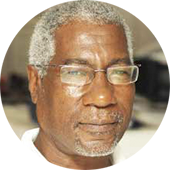
Approaching 44 years since W. Arthur Lewis became the first Saint Lucian to win a Nobel Prize and 31 years since Derek Walcott became the second and made this island one of the smallest nations with the highest number of Nobel Laureates per head of population globally; and on the eve of their 45th Independence Anniversary, citizens are still learning to honour and searching for the heroes and the freedom fighters who laid the path for all that followed.
Saint Lucia has two Nobel Laureates, two national heroes (George F.L Charles and John G.M. Compton), as well as two languages, two pitons, two major airports, two major seaports, two international IT service providers – and even two separate holidays for Independence and National Day, but no National Heroes Day…
Lewis and Walcott are honoured annually for putting the island on the world map, but successive generations know and/or are taught not very much at school about why they became who they were and the roads they followed to get there.
Introduction of annual Emancipation Month observances came off to a good start last year, with Saint Lucians at home and abroad learning a bit more about the valiant struggles, fights and battles our enslaved forebears fought before, during and after Emancipation and for Reparations for Slavery and Native Genocide.
More also came to light last year about unsung heroes like Joseph Seligny Baron, a Saint Lucian who earned wealth as a merchant in Shanghai in China and committed much of it, in his will, to construction of the gothic-styled Senior Citizens Home at Malgretoute in Soufriere in 1784 and after whom Baron’s Drive (along the Soufriere waterfront leading to the home) was named.
Soufriere and Saint Lucia also learned more about the valiant Battle of Rabot, where local freedom fighters beat back the British and ended slavery on the island in 1795 — for an entire year — before being overrun in 1796 in Castries by an overwhelming combined colonial force of over 17,000 British and French soldiers.
Dennery and Saint Lucia were happy to learn too about the exploits of Petronille, an enslaved woman who was ‘pilloried’ to death in 1833 (tied, locked and beaten in a steel cage) for refusing to work and daring to escape, resulting in a revolt by fellow enslaved at Fond d’Or Estate.
The first Emancipation Month also shed a little light on the sterling advocacy of John Quinlan, a surveyor from La Clery in Castries championed the causes of formerly-enslaved persons in Saint Lucia and Saint Vincent and the Grenadines, was a key figure in the Pan African Congress at the turn of the century in 1900, presented to the English Royal Commission on Reparations or Repatriation for millions of ex-slaves in the Caribbean and other British colonies after Abolition in 1897.
The Cultural Development Foundation (CDF) and the stakeholder committee organizing the annual Emancipation Month observances has reviewed 2022 and already started working on 2023, learning from and being guided by the experiences and lessons gained.
The momentum that came with the launch and unveiling on July 31, 2022 of the Petronille monument in Dennery and the August 1 Freedom March along the John Compton highway that culminated with the impressive show on the Castries Waterfront, which was broadcast live but missed by many, who now eagerly look forward to the 2023 version, while more communities will want to participate in the ongoing process of identifying and paying appropriate tribute to unsung heroes.
The Archives Authority, for Nobel Laureates Week 2023, launched an exhibition featuring Darren Sammy and Levern Spencer, the island’s two best-known international sporting heroes in cricket and athletics, respectively, about who we know not enough about how they got there and at what cost.
The lecture delivered by Dr June Soomer on January 19 was a stunner that drew much-appreciated reviews and the Nobel Laureates Festivals Commission must again be congratulated for keeping the island’s Nobel laureates alive in our minds and spirits.
Much will be done this year and more will be achieved by way of digging deeper into the past to find our now and better see our future, but those still here who crept and walked those longer miles that made our current journey, the shorter ones they are must never be forgotten, like: Gregor Williams and his wife Deidre, who’ve written their names into our history by virtue of their own research and writings; Monsignor Dr Patrick Anthony, Dame Pearlette Louisy, Archives Authority Director Margot Thomas; and writers Morgan Dalphinis, Adrian Augier, Kendel Hippolyte, Vladimir Lucien, Mc Donald Dixon, Robert Lee and Anderson Reynolds (and the many, many more other honorable senior citizens, at home and abroad, who we know and don’t…)
Much also needs to be done, as of now, to work with families of those forbears who’ve left troves of works of literature and art that need to be properly researched, documented and safeguarded for future sharing, such as historian Robert Devaux, former Director of Culture Jacques Compton, author Garth St. Omer, national artist Dunstan St. Omer, etc.
The family of the late former Speaker of the House of Assembly and Editor of The Voice newspaper W. St. Clair Daniel set a good example a few years ago by donating his rich library to the Monsignor Patrick Anthony Folk Research Center for proper documentation and research – a move worthy of much commendation and emulation.
This year has also seen the launch of ‘They Called Him Brother George’ (in memory of George Odlum); Peter Josie has also written extensively on politics and Rick Wayne, Guy Ellis and other media writers have left volumes of published articles over their decades in the trenches.
The thirst for information on heroes will only always grow and can only be quenched, though not ended, with more true stories about who we are and from whence we cometh.












